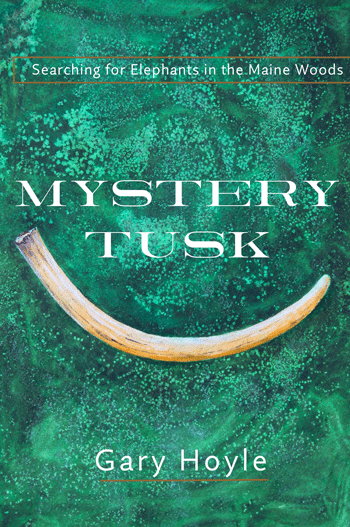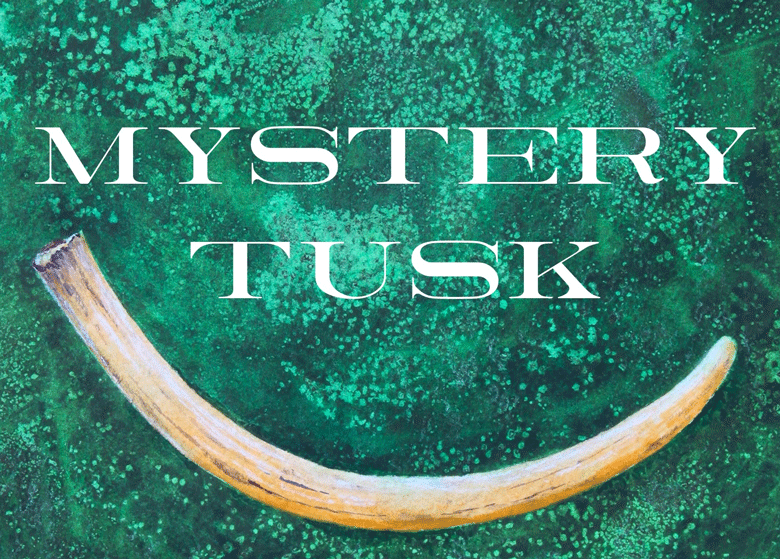Mystery Tusk: Searching for Elephants in the Maine Woods
North Country Press, 2022
Review by Carl Little
If you’re planning to start digging for Paleolithic remains in Maine, for heaven’s sake, first read Gary Hoyle’s Mystery Tusk: Searching for Elephants in the Maine Woods. With the enthusiasm and skill of a committed storyteller, Hoyle offers a step-by-step account of the “largest paleontological excavation in Maine history.”
The mammoth—its tusk—first appeared in August 1959 encased in clay in a muddy pool in Scarborough. A major news story of the day, the find would not be confirmed until the early 1990s when Hoyle and a team of experts, assisted by dedicated volunteers used modern methods, including radiocarbon dating and exhumed additional body parts—a mandible, a molar, some bones—to verify its origins.
Thought to be a female, the mammoth became known as Hairy-it, the author’s affectionate nickname.
A major news story of the day, the find would not be confirmed until the early 1990s…
Hoyle takes us through the high and low points of the project, the bureaucratic hoops and funding barrels. His dedication to the project is perhaps exemplified by his volunteering for a dinosaur dig in Montana one summer in order to gain new sleuthing skills.
He also came up with an ingenious method for mapping out the excavation site: an ice scriber, a tool once used by ice harvesters in Maine to mark off the frozen surface of ponds and lakes.

In the chapter titled “Goodbye, Hairy-it,” Hoyle imagines the course of the creature’s life. “Looking into deep time,” he writes, “is a bit like looking through a plate glass window at a shrub-studded meadow on a foggy day.” His account cuts through the fog in a loving manner.
Cameos by the likes of historian and journalist Herb Adams, meteorologist Lou McNally, and famed Natural History Museum diorama designer Fred Scherer (1915-2013) add to the storyline. The last-named mentored Hoyle when he joined the Maine State Museum staff as a research associate in 1973.
A recent “Behind the Scenes” video from the museum relates the sad fate of some of their brilliant creations for the “Back to Nature” exhibit, which after 50 years is being dismantled due to deterioration.
About a third of the way through the book, Hoyle begins to interweave a second story of research and revelation: the fate of “Old Bet,” said to be the first elephant to set foot in America (it arrived in New York City from India in 1796).
At the time of the initial tusk discovery, a reporter, Waldo Pray, ventured to wonder if the appendage might have belonged to Old Bet, shot to death by a crazed farmer in Alfred in 1816. In seeking to set the record straight, Hoyle branched off from Hairy-it to follow the life and times of an elephant that would eventually set P. T. Barnum on a journey that led to the greatest show on Earth.
Hoyle, who is a fine artist (see “’Creators in Arms’ on Swans Island,” Island Journal, 2019), provides most of the illustrations for the book, including drawings and paintings of the mammoth and Old Bet. His art reflects his dedication to natural science, but also our emotional attachment to magnificent creatures.
Elephants are a constant source of fascination and empathy. Consider the case of Happy, the Bronx Zoo elephant whose right to selfhood was denied by the courts last June. The first-day ceremony for a new “Forever” elephant postage stamp designed by Rafael Lopez was held on Aug. 12, World Elephant Day, at the Elephant Discovery Center in Hohenwald, Tenn. The center is part of the Elephant Sanctuary, which provides refuge for elephants that have retired from zoos and circuses.
Hoyle’s stories reconfirm our deep feelings for all things pachydermic. Thanks to him, mammoth and elephant live on, in Maine and in our imagination.
Carl Little’s latest book is Mary Alice Treworgy: A Maine Painter





